
An Easter Goose
April 3rd, 2018
The annual spring flood of Cobb's Lake Creek in Bourget is on, and as all passionate birders must, I made the pilgrimage--on Easter Sunday, as it turns out. When I saw all the white stuff up ahead and realized it wasn't snow, I knew it was going to be good.
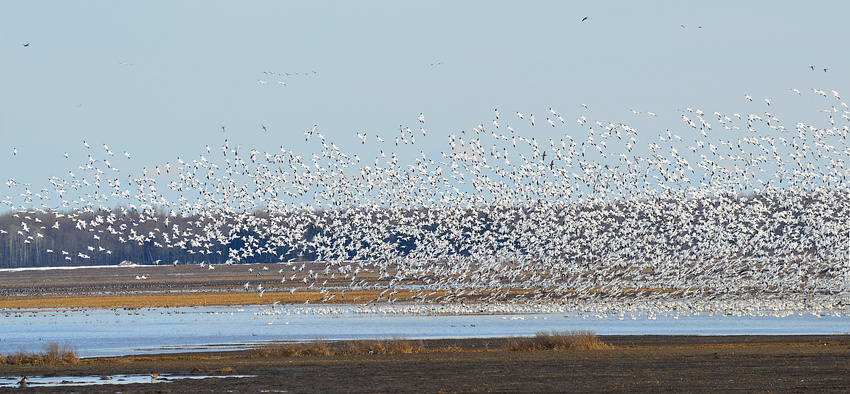
Ten thousand Snow Geese at a conservative estimate. But as I didn't get any good photos of the masses, I'm borrowing a shot I took two years ago (same spot, same time.)
The sight of them flying in skeins overhead, gleaming pearly white against blue sky, was just amazing. And those did lend themselves to good photos. The wind was fierce, it was only a couple degrees above zero, and the jacket I was wearing wasn't really designed for such conditions, but I must have been in love because I stayed out there for over an hour anyway.
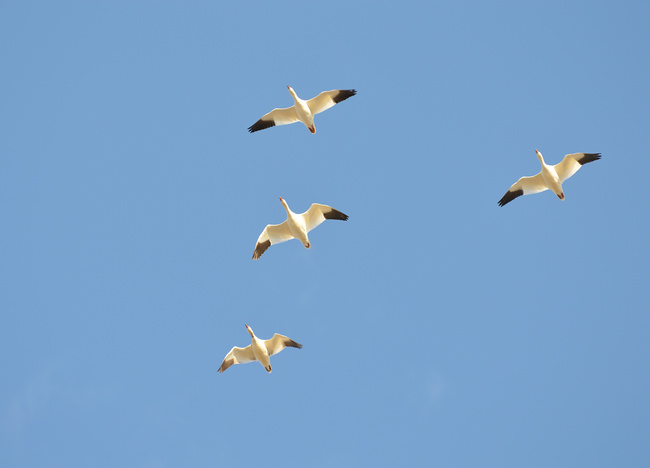

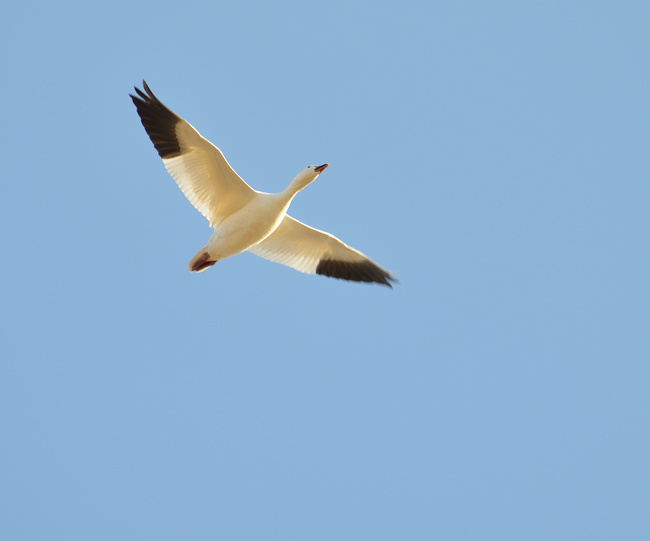
Eventually I finished with my "wow"s and settled down with the scope for a long scan. There were a bunch of them massed in a field across the road from the flood, not too far away, so I focused on those. Snow Goose has a dwarf-lookalike called the Ross's Goose, a cute Mallard-sized goose with a stubby little bill. It's rare, but when you've got ten thousand Snow Geese in one place, there's a good chance of at least one in there, somewhere...if you can find it. It's always been a nemesis bird for me. And I've never understood how people manage to scan a tight-packed flock of ten spabillion white geese and pick out the one odd white goose.
I grumbled to myself about how impossible it was. Grumbled and mumbled right up until the moment when I saw a tantalizingly petite white goose, with a tantalizingly stubby bill, amidst the masses. I struggled to keep a lock on it. It helped that it was in the vanguard of its little cluster as they ambled left, and that a pair of Canada Geese (a small minority, for a change) were nearby as a landmark. I took some hurried photos--so hurried that I forgot to check my exposure and they came out overexposed and awful. But they were enough. Jon Ruddy and other experts confirmed that I had my lifer Ross's Goose!
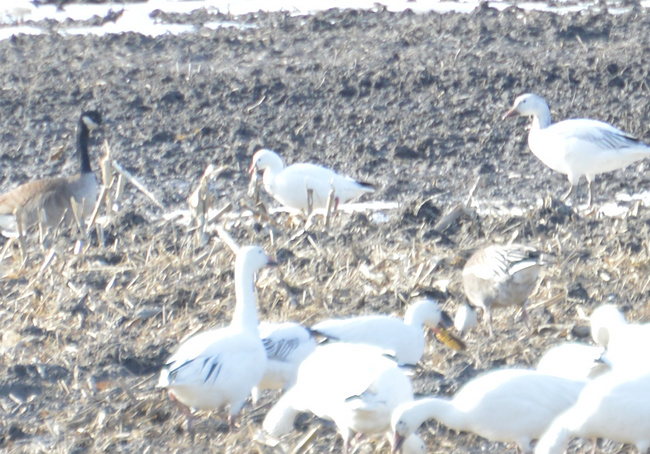
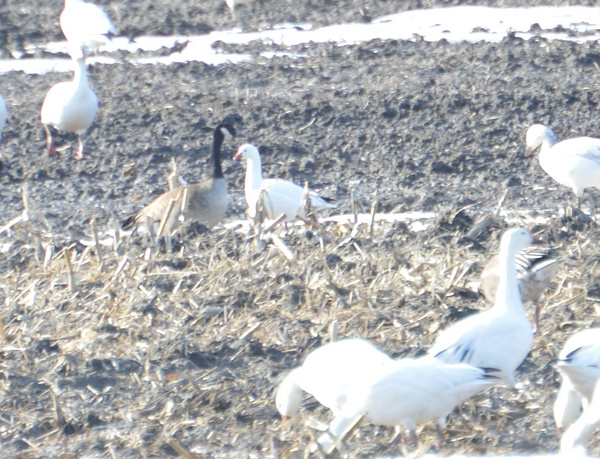
Early thaw, aborted
March 17th, 2018
For most of the winter, except for our brief jaunt to the southern states, I've been hibernating indoors. I just don't tolerate Canadian winter as well as I did when I was younger. A few weeks ago I thought the long cold wait was over. And I wasn't the only one! On the 27th of February I tallied a Red-winged Blackbird outside my husband's work, my earliest ever. On the 4th of this month, we both drove out to the Carp River floodplain and enjoyed the spectacle of a thousand plus Canada Geese, along with a handful of Cackling Geese (Canada Goose's diminutive lookalike) and two Greater White-Fronted Geese. That last is an uncommon species in Ottawa, and I got one of my best looks at it ever.
And then temperatures plummeted. And a whole bunch of snow fell. People have reported seeing masses of geese fly south. I don't blame them.
But today my body said, "minus five or not, I want a walk." I'm glad I listened. I spent a couple hours at South March Conservation Forest enjoying the sun and the birds. Purple Finches sang along the trail, and Brown Creepers and Downy Woodpeckers spiralled up tree trunks. As for the Red-winged Blackbirds, they seem to have decided, "darnit, we're here now and we're NOT turning around and going back." They were staked out over the frozen marsh, conk-a-reeing away.
Tonight I'm putting both feeders up. I think my molting goldfinches will appreciate the extra food after it hits -19C tonight.
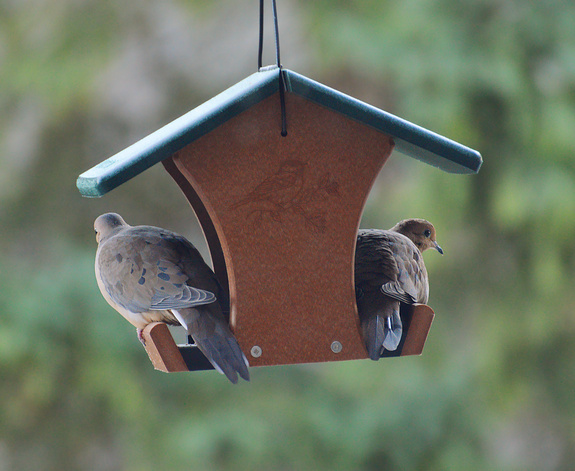
Mourning Doves at feeder, November 21st
In Love With Dutch Gap (part 3)
January 23rd, 2018
On the 27th Michael and I made one final outing to Dutch Gap, featuring three exciting photographic firsts: three birds that I had either never photographed before, or never photographed well. None of them were ducks, oddly enough!
The first was this beautiful little falcon, an American Kestrel:

While I've seen kestrels often enough, usually in rural areas, they always seem to fly away before I can take a picture. I photographed this one from the car and managed to get a few good shots in before he spooked.
For the second photographic first, I thank the very cold weather that day (even colder than the last), which was slowing down the hyperactive kinglets. This is the first photo I've ever gotten of a Golden-Crowned Kinglet that I'm happy with. Though it may not look it in the close-up, this bird is even tinier than the Ruby-Crowned Kinglet pictured in the previous post.
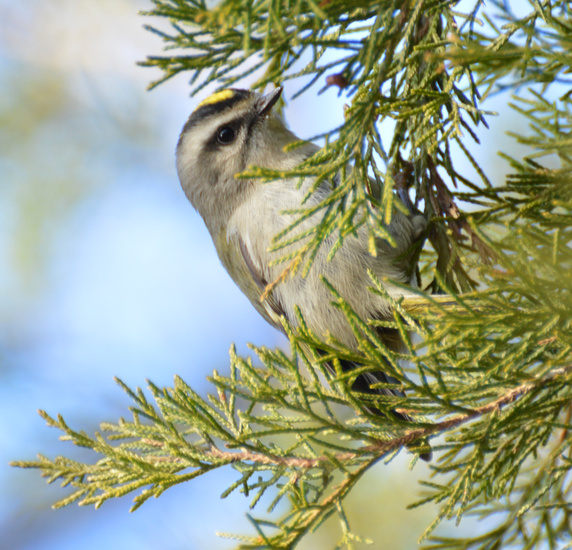
The third first involved the undisputed high point of our outing, a magnificent Barred Owl. The photos don't do it justice, but they are my first-ever showable photos of the species. (I only wish I'd had my camera with me when I saw one of these beauties a few winters back in the Gatineau, almost close enough to touch!)
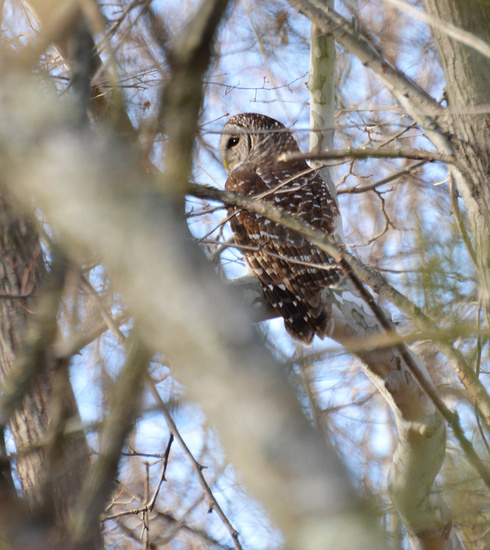
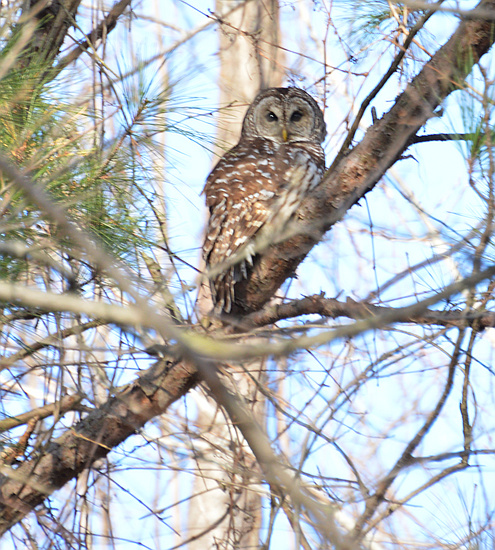
Even though it is a common species, of the nine owls on my lifelist, Barred is my favorite. I love its dark, brooding eyes and its strange call.
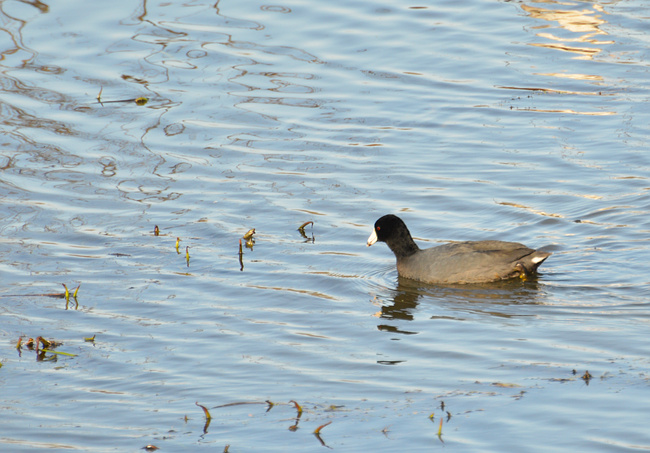
American Coot
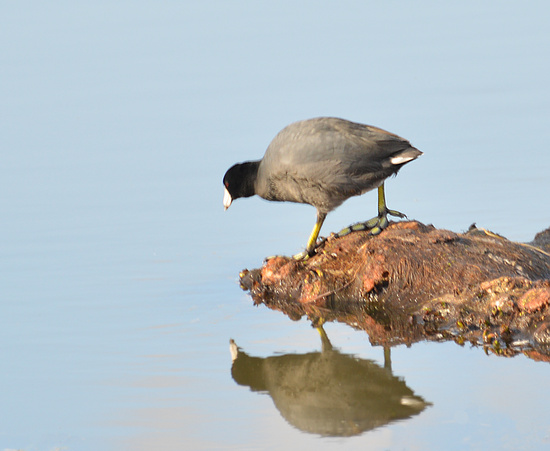
American Coot
Another things that gives coots away as non-ducks: their weird feet.
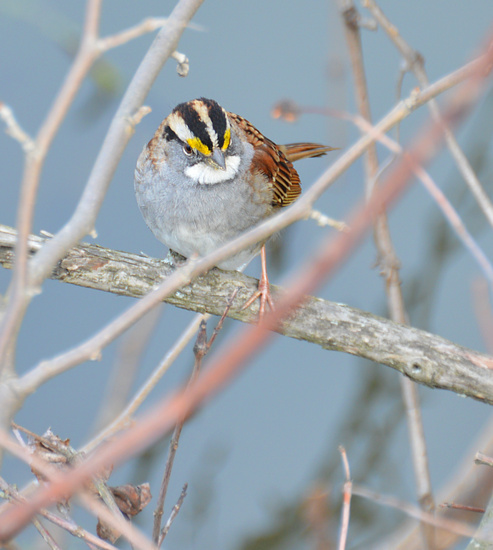
White-Throated Sparrow
There's something unusual about the White-Throated Sparrow. If you'd like to know the story, read on.
( Herein )
In Love With Dutch Gap (part 2)
January 13th, 2018
On my second visit to Dutch Gap (the day after Christmas), it was the Gadwall who came in close.
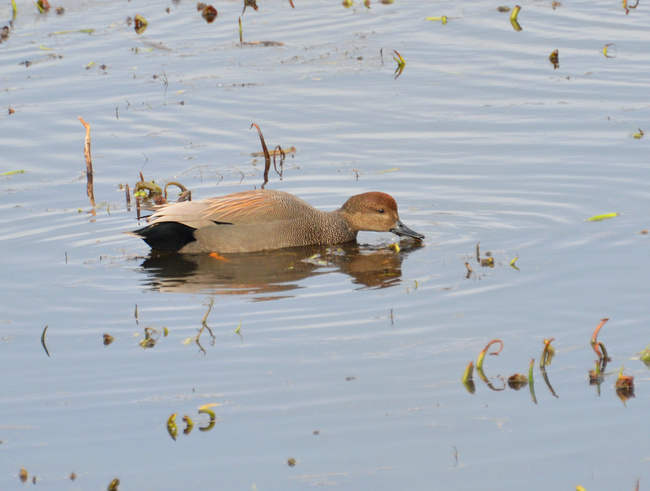
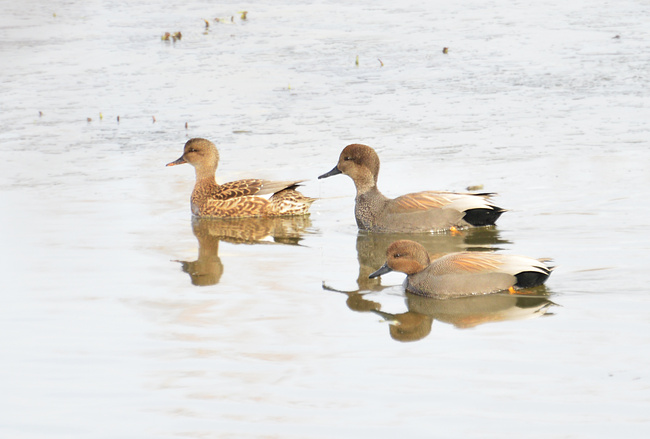
(female in front, two males behind)
"Understated elegance" is how AllAboutBirds describes them. I agree with that. Gadwall drakes aren't flashy, but I find them handsome. I particularly like those softly peach-tinted back feathers. When they take flight, they reveal chestnut wing patches, and both sexes show striking white wing patches that help identify them at a distance.
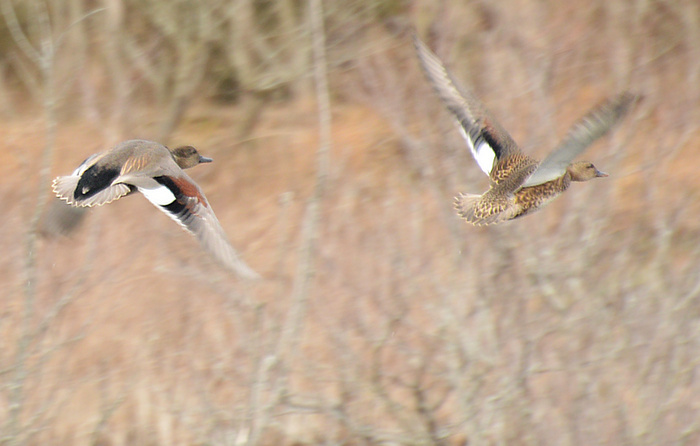
(female in front, male behind)
A tiny Ruby-Crowned Kinglet distracted me away from the ducks as it foraged in the marshside vegetation. It was a cold morning (for Virginia), and cold mornings are always the best time for viewing kinglets! (When it's warm enough to get them up to speed, they move at approximately the speed of sound. At least it feels that way when you're trying to photograph one.) Both species of kinglets (Ruby-Crowned and Golden-Crowned) winter in Virginia and are a common sight, even in suburban front yards, though likely unnoticed by non-birders. They are some of the smallest birds in North America after hummingbirds.
Note in each of these photos the teeny glimpse of the hidden ruby crown, identifying this as a male.
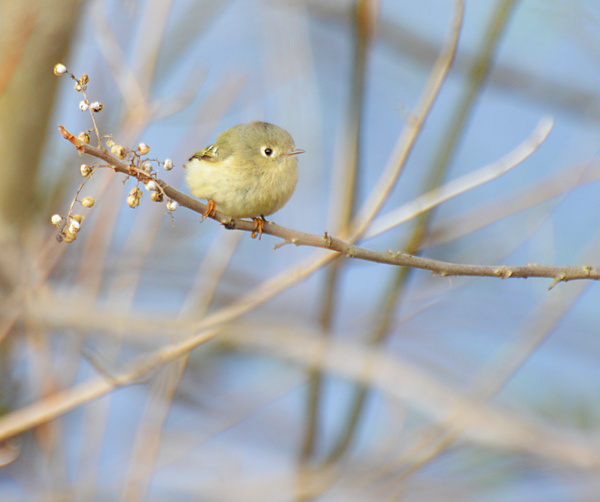
Ruby-Crowned Kinglet
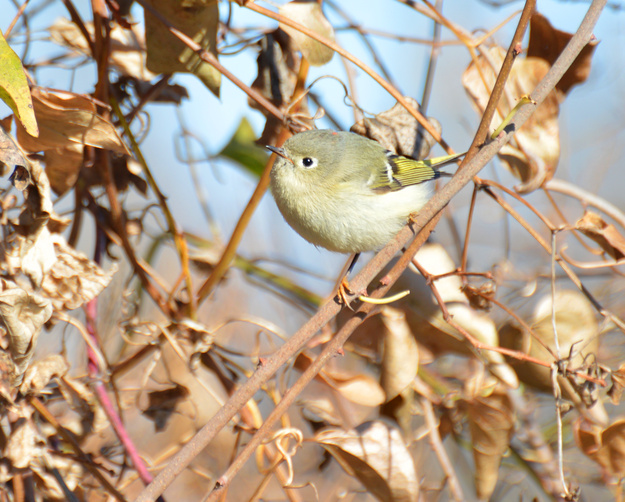
Ruby-Crowned Kinglet
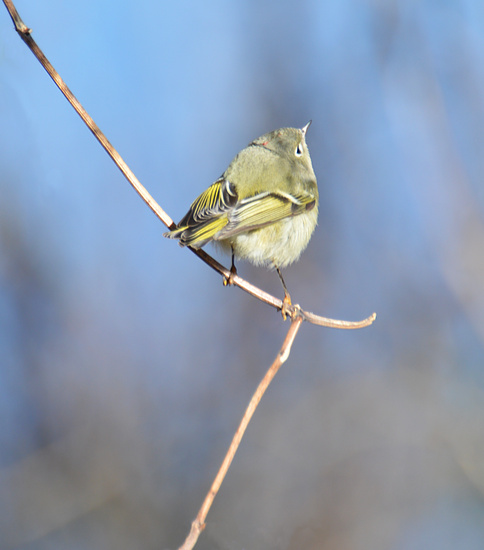
Ruby-Crowned Kinglet
( More (Mockingbird, Brown Thrasher, Field Sparrow, Bald Eagle) )
In Love With Dutch Gap (part 1)
January 11th, 2018
Michael and I spent a week in Virginia this Christmas, sharing the holidays with my parents. And I managed three outings to Dutch Gap, each of them wonderful in its own way.
Dutch Gap is a conservation area on the James River and one of my favorite places in the world. A rather superlative statement, I know, especially for someone who has birded Costa Rica, but Dutch Gap is special to me. In summer, it's about the beautiful Prothonotary Warblers, brilliant golden birds who nest in tree holes in wooded swamps. At Dutch Gap they nest in bird boxes built especially for them, erected six feet or so above the water. You seem to hear their song around every corner. And they are easy to see, at least until you take your camera out.
But this time of year it's about the ducks. A diverse and abundant assortment of them winter in the marshes of Dutch Gap, viewable right from the roadside. They can sometimes become quite tame. My high counts this trip included, among others, 40 American Wigeons, 100 Gadwall, 10 Northern Pintails, 40 Northern Shovelers, and a whopping 160 Wood Ducks. (Those counts are all loose but conservative, based on what I could see with binoculars and spotting scope from the various overlooks. There were doubtless more!)
I guess ducks are some of my favorite birds. They have such character about them. The gentle Gadwalls, the stern yet comical Ring-Necked Ducks, the ungainly Shovelers. And for the first time I was able to capture them well. I fell in love anew with each species as I was processing their photos.
My first outing, on the 23rd with Michael, had me in a sorry state. I was worn out from travel and having difficulty adjusting to being away from home. But the marshes lifted my spirits.
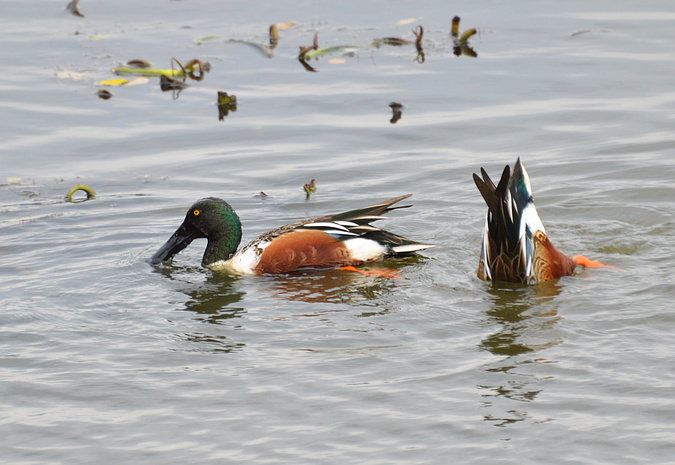
A Northern Shoveler dabbles for food with his oversized bill, while another tips up. There were dozens of them swimming close in that day.
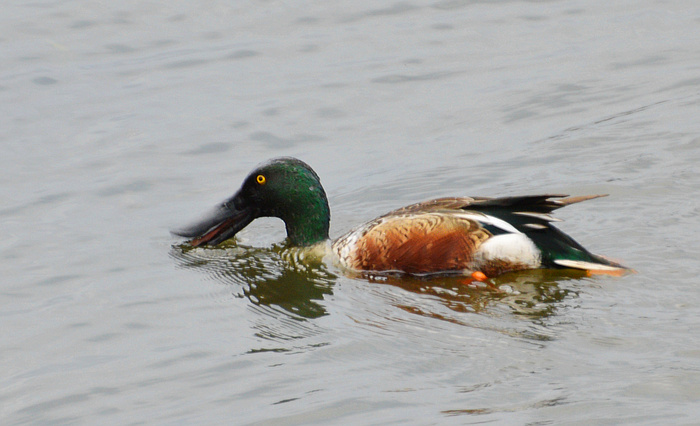
Northern Shovelers have comb-like structures called lamellae on the edges of their oversized bills. As they dip their bills in the water, the lamellae strain out tiny crustaceans and other food items.
I noticed a few of them doing something I'd never seen them do before. Two ducks would slowly spin together while dabbling, creating a gentle vortex with them at its center. It was reminiscent of what phalaropes do, and likely for the same purpose (to draw food items up to the surface), but the shovelers preferred to do it in pairs. Visually they reminded me of a yin yang.
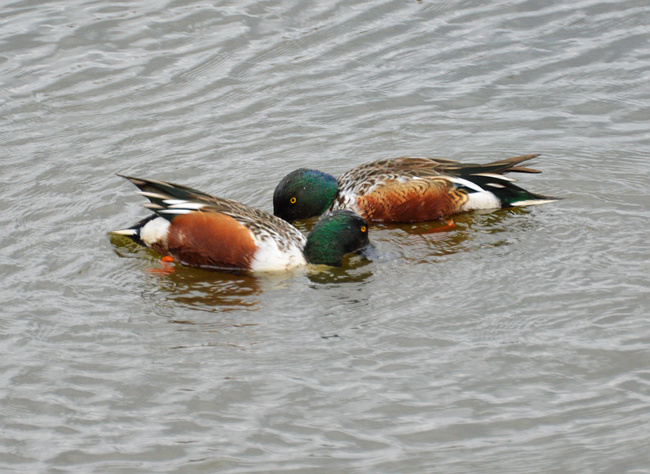
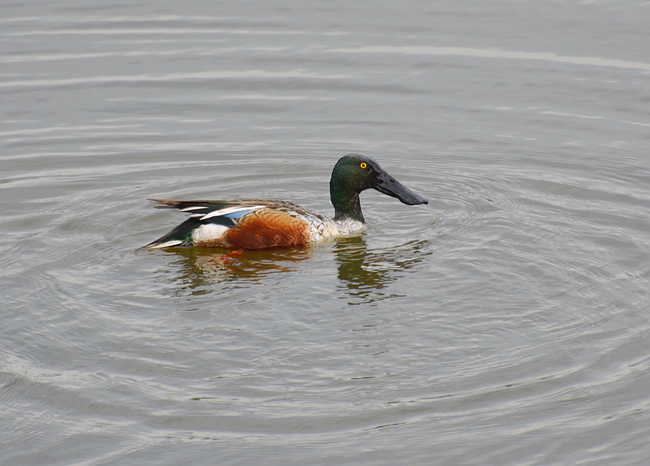
Note the vortex around this fellow. I think this is one who was spinning by himself.
The other stars of the day were the Ring-Necked Ducks. These diving ducks like shallower water than their relatives, and often hang out with dabblers in marshes and ponds, while the more dedicated divers keep to rivers, lakes and ocean bays. I had struggled to do the shovelers justice in the overcast lighting that day, but for the ring-neckeds it was no problem at all. They're naturally monochrome.
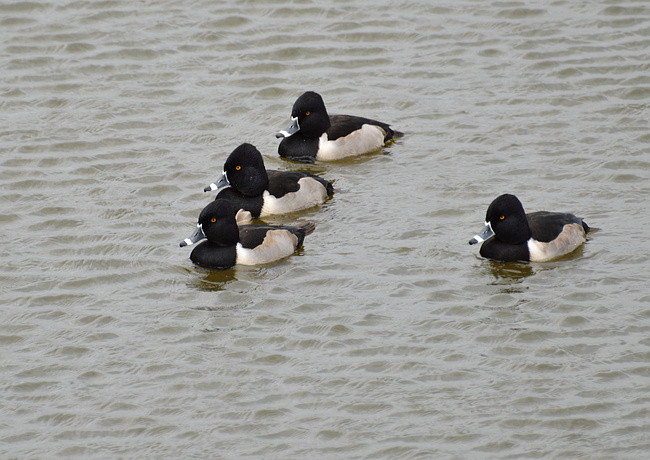
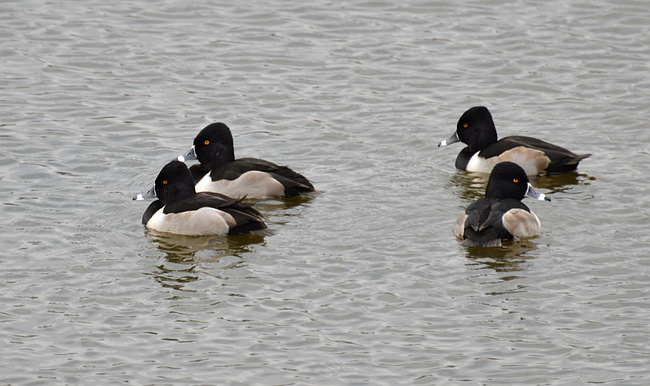
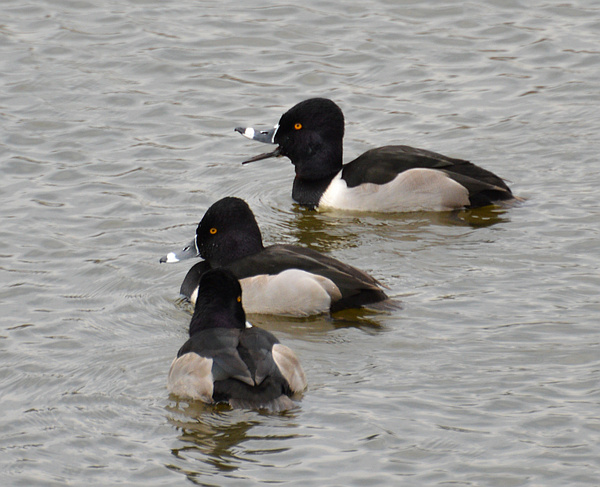
(If you're wondering why these ducks are called "Ring-Necked" and not "Ring-Billed", you're not the first. They do have a very subtle chestnut ring around their necks, visible at close range--as in, to someone who is holding a specimen in their hands. It is seldom seen by the rest of us.)
( More (American Coot, squabbling gulls) )
Life Bird #473
December 21st, 2017
(Part 1)
The next day I tried again and hit gold. The Black-Throated Gray Warbler appeared east of the ridge. Many birders that day enjoyed good views and, for the camera-equipped, photo ops as it actively foraged in a stand of buckthorn.
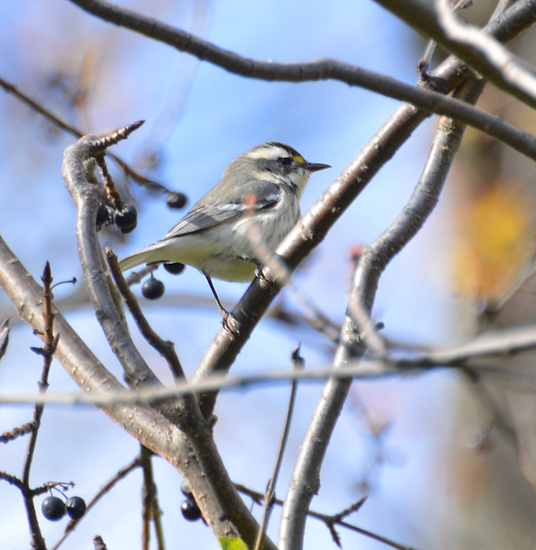
Black-Throated Gray Warbler breeds in the west from Arizona and New Mexico, up to the southwestern tip of British Columbia. It prefers pine and mixed oak-pine forests. Like most warblers, it is a dedicated insectivore (although, as suggested by its attraction to buckthorns at Mud Lake, it will also take the occasional berry.) This bird is often considered part of a "superspecies" with the closely related warblers Black-Throated Green (our local representative), Townsend's, Hermit, and Golden-Cheeked. It is the least colorful of the bunch (unsurprising for a southwest bird), but still has a certain somber handsomeness about it and a little spot of color, especially on the breeding adult male. The one in Ottawa was probably a young (first-year) bird.
Sadly, but not unexpectedly, this lost waif was not able to contend with an Ottawa winter. It did surprisingly well for awhile, until the big snow arrived. That morning, Bruce di Labio went to Mud Lake and found it lying motionless at the base of a tree. He picked it up and cradled it in his hand to try to warm it, but it was too late. A silver lining on the cloud is that now the Royal Ontario Museum has a specimen for a very rare bird in our region.
I find it interesting that the same man who found the warbler was the man who was there to try to rescue it in its final moments. It was the same with the Bullock's Oriole in Pakenham: Ray Holland found it, and Ray Holland was there to rescue it when the winter turned harsh. (And for the oriole the ending was happy: it was eventually released in British Columbia after convalescing at the Wild Bird Care Centre.) Even though many, many people went to see both birds, those men were there when it counted. It speaks to their dedication and their skill as field-naturalists.
And now for more photographs from Mud Lake.
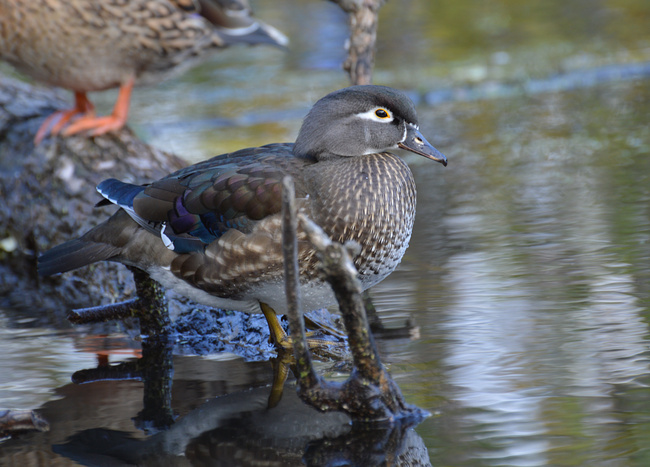
Wood Duck (female)

Wood Duck (male)
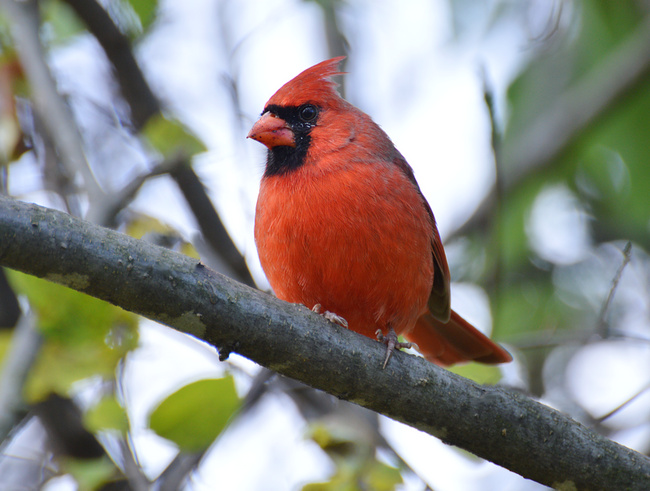
Northern Cardinal
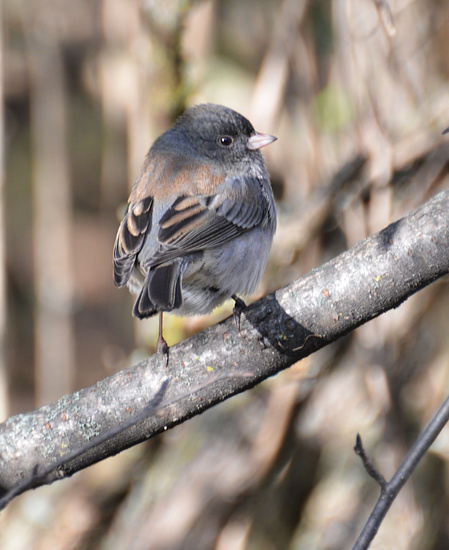
Dark-Eyed Junco
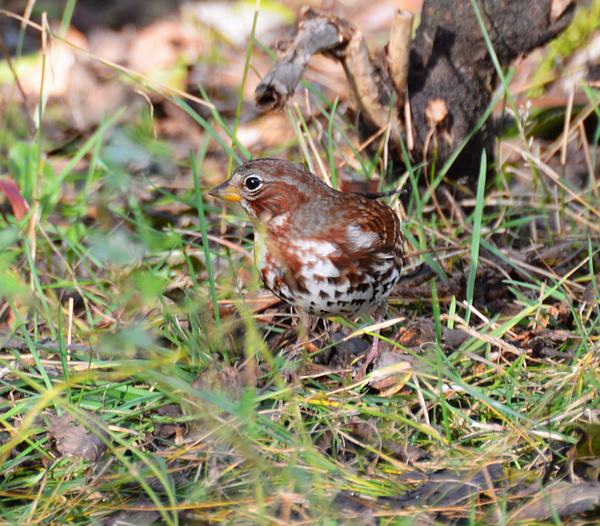
Fox Sparrow
Fox Sparrows only appear in Ottawa in migration. This one was a little late moving on to its wintering grounds (but much better able to deal with being late than an insectivorous warbler.) It was in with a group of White-Throated Sparrows and Dark-Eyed Juncos, all coming out to forage on birdseed that someone had scattered on the trail. But it was much shyer than they, quickly darting back undercover whenever a human got close. I've only managed a few photos of this bashful sparrow (one of my favorites) over the years, and I still haven't gotten one that I'm truly happy with.
Catching Up
December 20th, 2017
It's time--long past time, really--for a catch-up post, before Michael and I head to Virginia for Christmas vacation. (I'm going to be rambling a bit for the next five paragraphs, so click here if you prefer to skip straight to the photos.)
Like last year, I've ramped down my nature photography for the cold season. When I do manage to coax myself out into the Ottawa winter, my focus is on seeking beauty and enjoying it in the moment (rather than taking myself out of the moment to capture it), and getting enough exercise to stave off seasonal affective. However, I made two trips out to Mud Lake in early November in search of an ultra-rare Black-Throated Gray Warbler, and I brought the camera both times. I'll share those photos in this post and the next.
And the camera will be going with me to Virginia. I very much look forward to seeing the incredible array of wintering ducks at Dutch Gap, and maybe capturing them. Chesterfield had t-shirt weather today. I can only hope it will offer some of the same after our arrival! And I can only hope the trip works out and lasts long enough to catch Virginia at its best. I have been having major sensory processing issues, which more or less torched my last attempt at travel (Point Pelee in May.) I'm tired of not travelling due to these issues--as much as I love my home city, I'm tired of only seeing Ottawa birds.
I'm eBirding these days. (That's a link to my eBird profile, but note that you have to be registered on eBird to view it.) i.e. reporting the results of my birding outings (and sometimes feeder watches) to the huge public database run by Cornell. This is increasingly popular among birders, and increasingly being used by scientists for tracking the distribution of species around the globe.
Relatedly, I've been working on a program for recording bird sightings locally (i.e. on my own computer) and personally. It's sort of eaten my life, though in a good way. I've enjoyed the coding, and finally, now, am enjoying the fruits of it. The nucleus of the idea was my dissatisfaction with eBird's query abilities and its impersonal nature. Although I'm not going to stop eBirding, I wanted in addition something more like Birder's Diary, but that runs natively in Linux (my preferred platform.) I wanted to be able to easily ask, for instance, "where have I seen Scarlet Tanager in June and July?" And I wanted a platform for storing personal thoughts about my birding trips, not just dry scientific data.
I now have all these things in BirdDB! It's a Perl library with a terminal-based app running on top, and my next step will be a GUI app. I haven't decided yet whether I will ever release any of it for public use. I don't know how big of an intersection there is between the already small groups "serious birders for whom eBird isn't enough", and "linux geeks." I suspect not a big one. (Besides, there is actually already a birding program that runs on linux. It's in Java. The truth is I made BirdDB more because I really wanted an interesting programming project, than because there were no existing alternatives.)
So a Black-Throated Gray Warbler showed up in Ottawa, our second ever. It is a bird primarily of the American southwest, though its range does tip up into southernmost British Columbia. It should have flown to Mexico in fall, instead, somehow, it ended up here. It was first found on the second of November at Mud Lake, and ended up lingering there until mid-December, when winter came in with a vengeance.
The afternoon of the day it was first reported, a rainy afternoon, I went to Mud Lake and soaked myself and my optics to the bone looking for it. No dice. I settled for photographing common birds, and promised myself I would be back the next day to try again.
Note: Husband and I finally got a new 1920x1080 monitor, so that's the res I use for wallpapers now. Click through to the gallery for wallpaper links for the first and third of these.
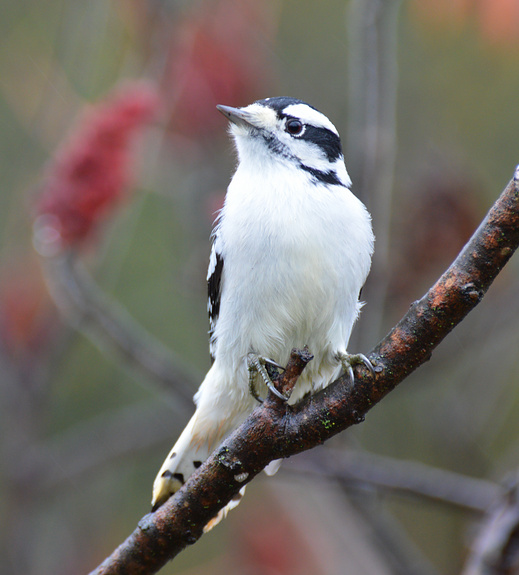
Downy Woodpecker
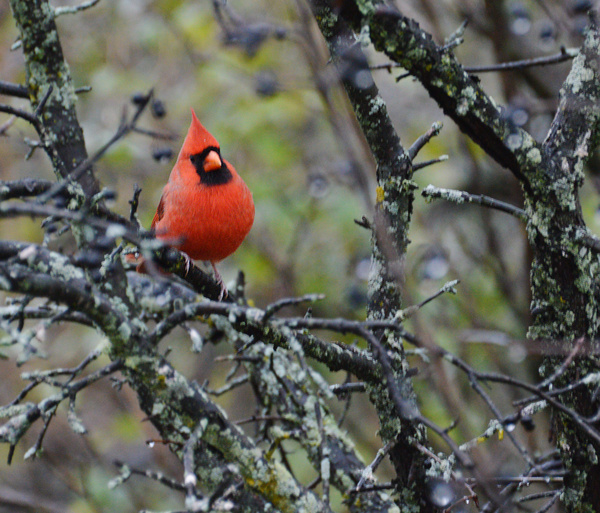
Northern Cardinal
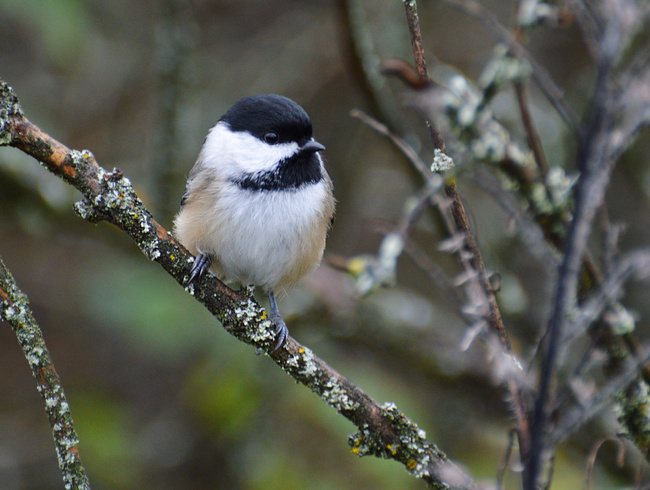
Black-Capped Chickadee
(Continued in next post.)
A Wet Morning On The Tracks
August 12th, 2017
On July 4th I headed to Huntmar Drive intending to hike the west side of South March Conservation Forest. But I found the Carp River swollen and flooded from our heavy rains, with tantalizing water bird calls coming from within: Pied-Billed Grebe, Northern Waterthrush (it's certainly been The Summer of the Waterthrush for me), Virginia Rail. It was so flooded that the lot where I used to park for South March was under at least a foot of water. A Great Egret flew over heading for the river, followed by a Great Blue Heron. I decided to hike down the train tracks and bird the flood instead of the forest!
Unfortunately the water birds remained largely unseen. But I still found a few things worth photographing. The unexpected stars of the day were the snails. They were pretty up close, at least some of them (their shells ranged from pale yellow to vivid amber), but a little gross in terms of numbers. I've never seen so many snails. There were about as many snails on the railbed as there were pieces of gravel.
I chose this beauty for a closeup:
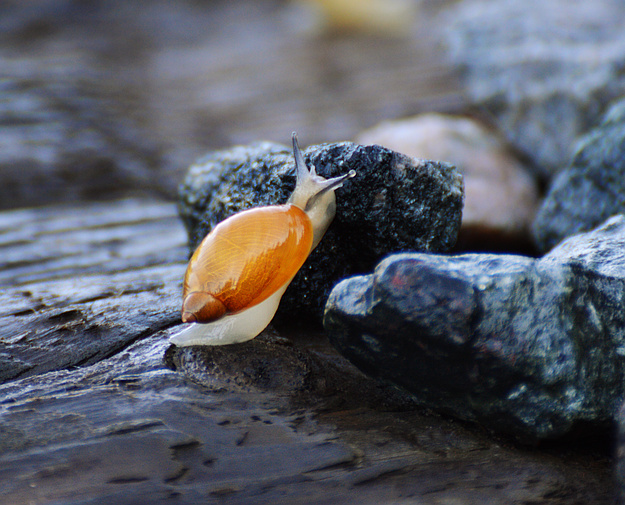
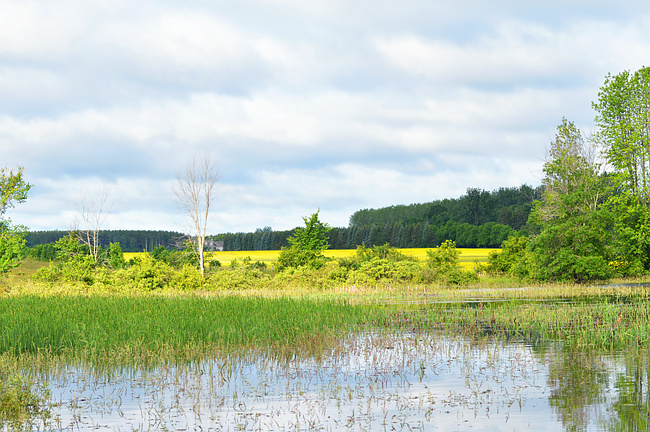
Looking out over Carp River wetlands and beyond. The field was even more vividly yellow than it appears here (a Canola crop?) I think Huntmar has some of the most scenic views in Ottawa.
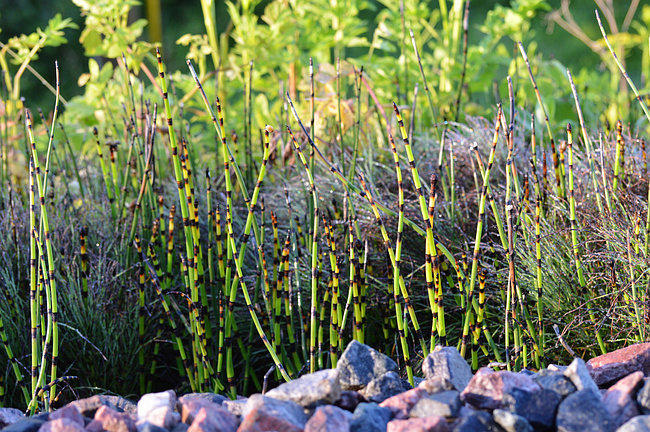
This bamboo-like plant is called Scouring Rush. It forms dense colonies in moist areas. The abrasive stems were once used in both the old and new world for scrubbing cookware.
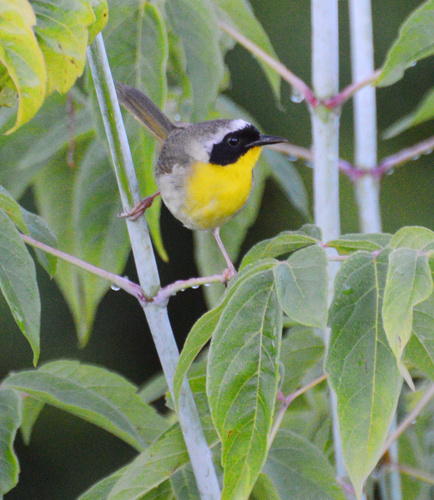
The only actual "water bird" I managed to photograph! Common Yellowthroats are abundant in brushy margins of wetlands, but typically remain hidden until pished or otherwise coaxed into view by a birder.
( More (flooded woods, Wild Turkey, American Robin) )
Early Morning In Marlborough Forest
August 4th, 2017
On the morning of June 21st I went back to Marlborough Forest to spend more time with the magnificent Showy Ladyslippers. I found them still glistening with dew and last night's rain. They had been radiant in the sunset, their colors brought out to the fullest, but this was a different sort of beauty, fresh and virginal like the Garden of Eden.

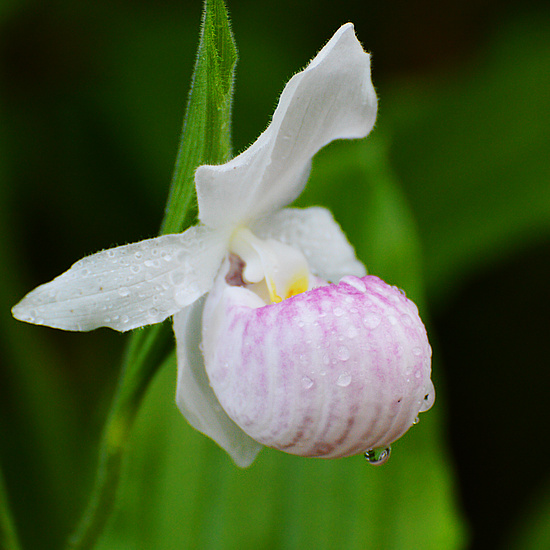
( More Showies )
On my past visit, Northern Waterthrush and Winter Wren sang in those swampy woods, hidden from view. This time I brought along my IPod to see if I could call them out with some recorded song. They both sang back fiercely (the loudest I've ever heard a Winter Wren sing, and that's saying something...) but were not forthcoming with good views. The wren perched in the shadows while searching for his (imaginary) rival, too poorly lit to photograph, while the waterthrush just darted over the trail from one hidden perch to another. It doesn't take much of this trickery, I find, before you start feeling like a right %&!*. So I discontinued playback, leaving each one confident that he had won and routed the intruder.
I had much better luck with another male waterthrush on a different territory. After only a brief few songs, he responded, first singing two hesitant notes ("uh, hello?") and then, after one more round from me, perching in view and singing away. Waterthrushes may be drab as warblers go, but they have long been among my favorite birds and I was delighted to finally get a photo of one.
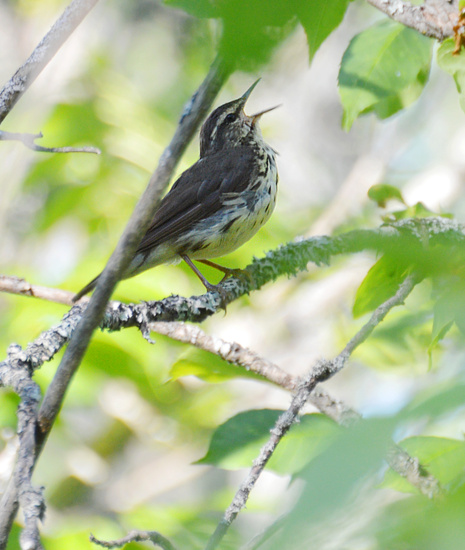
And now for something completely different.
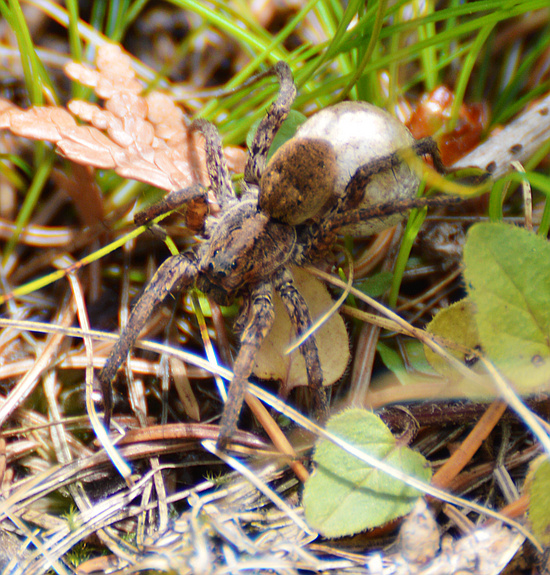
It was dragging that ball along through the vegetation. I think it's a wolf spider with her soon-to-be babies. Female wolf spiders are devoted mothers. After the spiderlings hatch, they will all crowd onto her back and travel with her wherever she goes.
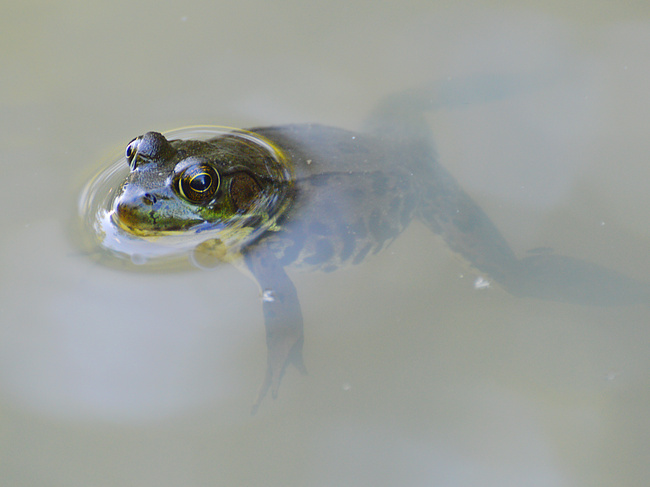
I had to wade into a puddle to get some of those Showy photos. This fellow kept me company.
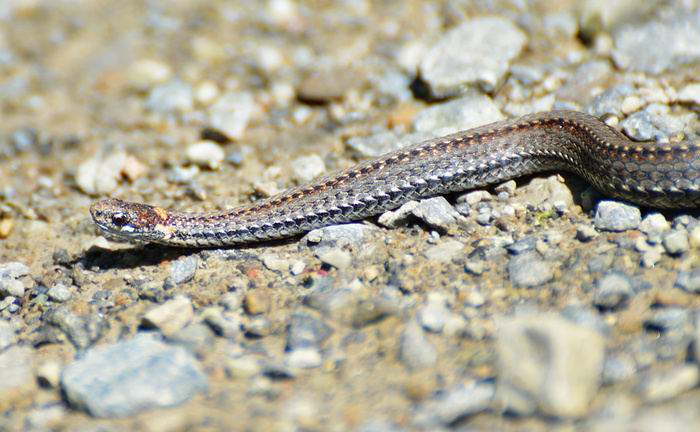
This small snake was basking on the trail. After some research, I learned that the markings on its head mean it's a Red-Bellied Snake. (I suspected at the time, but was unwilling to harass it into showing off its belly.) I'd only seen this species once before, and then it was in the beak of a kestrel. It is uncommon and usually rather shy. Like all of Ottawa's native snakes, it is harmless to humans.
A Price Worth Paying (part 3 of 3)
July 27th, 2017
(Part 1, Part 2)
It was near sunset when the best part of my day happened. It started with this:
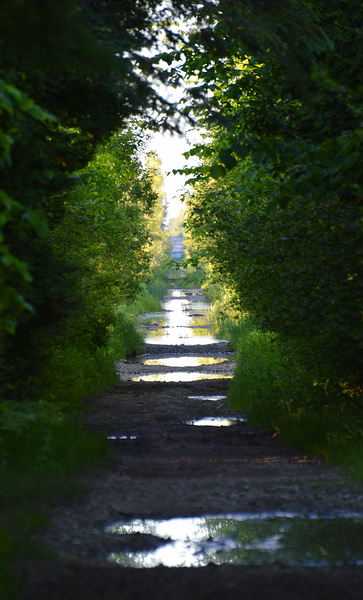
Abandon all hope of trail maintenance...
Okay, so turn back. It's time to get going anyway, get back to the car before dark...but there was just something so alluring about it. The flooded trail was somehow beautiful, beckoning. So I continued on, hoping that my shoes were as waterproof as they were advertised to be.
That continuing brought me to a colony of Showy Ladyslippers like nothing I'd ever seen. Not like the short, lonely, pale one I'd seen earlier, these were two feet tall, vividly colored and blossomed in clusters. There was nothing about them that would have been out of place in the most extravagant cultivated garden (if not for the fact that wild orchids almost never survive in gardens.) To stumble across such a sight alone, unaided, in the middle of nowhere...well, it's hard to do justice to it. The best I can put it is, imagine finding out that unicorns are real.
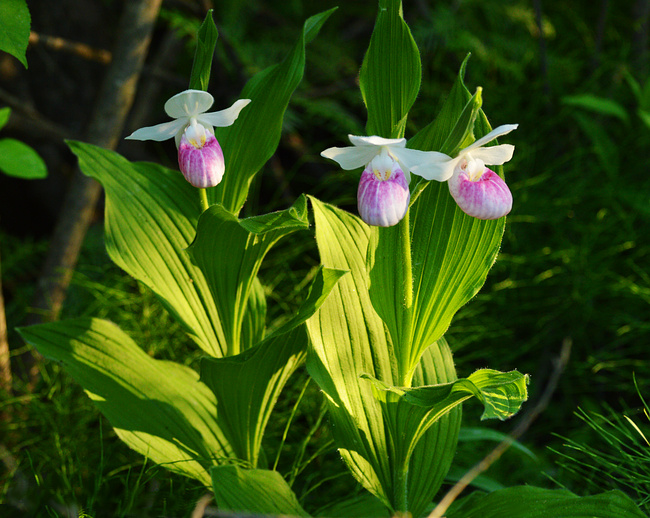
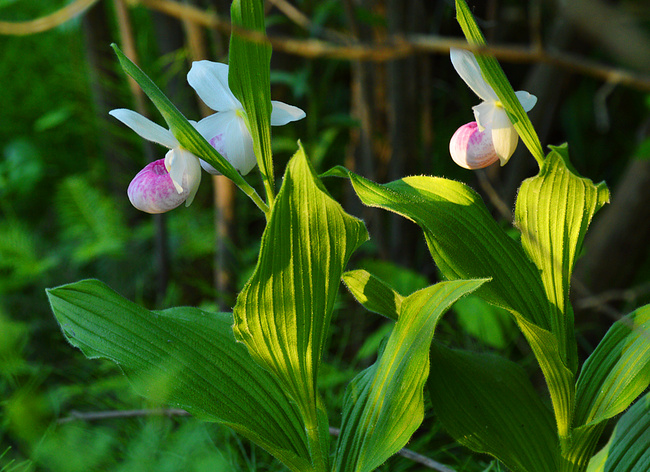
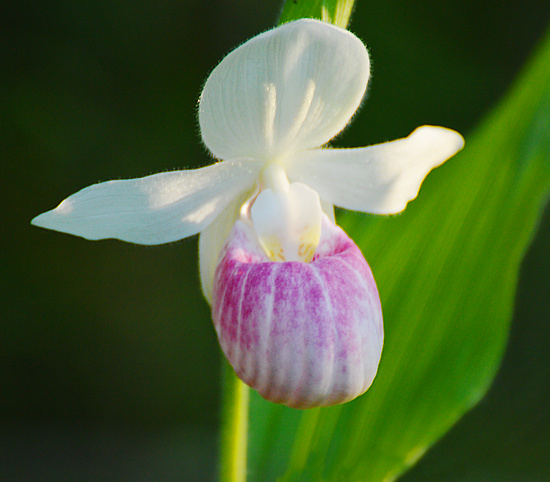
A relevant quote from Wildflowers of Ontario:
I'm not entirely convinced that this is a rare flower. The habitat which it prefers is simply not accessible to many people. [...] The only sane way to actually scout out this flower is to wear a bug jacket, a mosquito net over your head and latex gloves on your hands. I have never been bitten when I dress this way. I have, however, been accompanied by thousands of thirsty little mosquitoes as I look for this orchid. And that pretty well explains why most people have never seen a Showy Lady's Slipper, but it's worth the effort.
|
